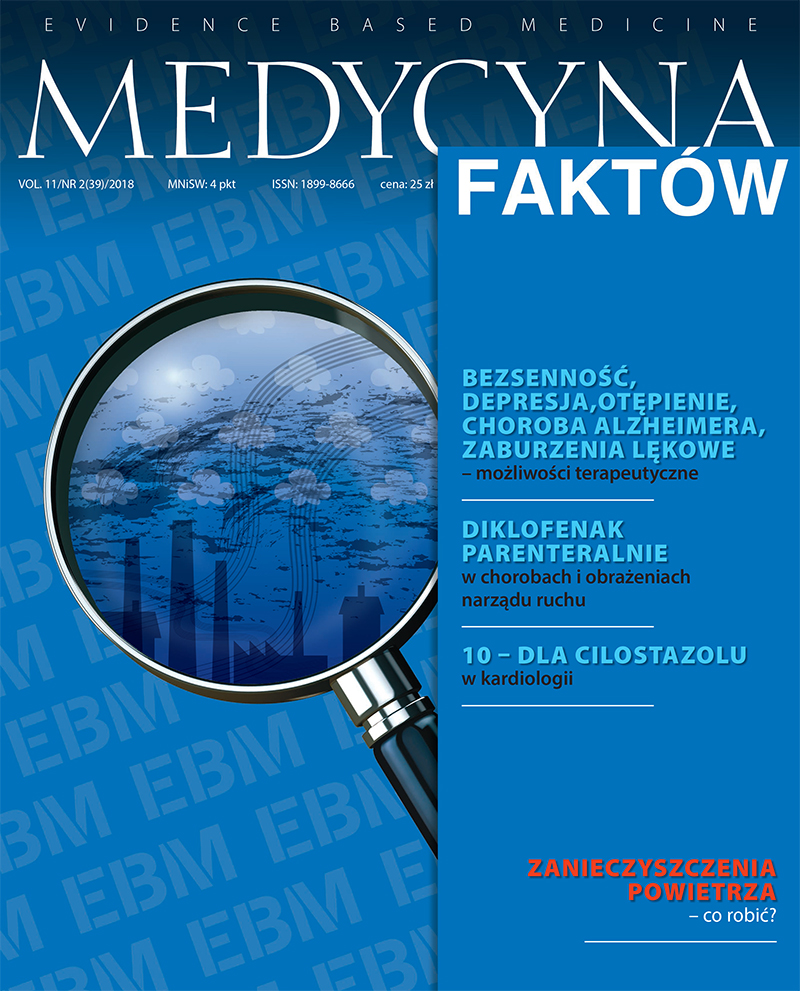What can be done about air pollution? Review article
Main Article Content
Abstract
Air pollution is one of the main causes of mortality worldwide. The most susceptible groups include the elderly and patients suffering from cardiovascular and respiratory diseases. Air pollution concentrations in Poland are among the worst in the European Union. Awareness of the sources and health impact of pollution is very low. Doctors should play an essential role in informing patients about air pollution, its consequences and actions that can be taken against it. Information should be concise and adjusted to individual. Many actions can be taken to reduce negative health effects of pollution: adjusting daily activity to pollution levels, using home air cleaners with HEPA filters and avoiding busy roads. It is important that patients know where to find reliable information about air pollution and what they can do to reduce personal exposure
Article Details
Copyright © by Medical Education. All rights reserved.
References
2. Landrigan P.J., Fuller R., Acosta N.J.R. et al.: The Lancet Commission on pollution and health. Lancet 2018; 391(10119): 462-512.
3. GBD 2015 Risk Factors Collaborators: Global, regional, and national comparative risk assessment of 79 behavioural, environmental and occupational, and metabolic risks or clusters of risks, 1990-2015: a systematic analysis for the Global Burden of Disease Study 2015. Lancet 2016; 388(10053): 1659-1724.
4. Mead M.N.: Who’s at risk? Gauging susceptibility to air pollutants. Environ. Health Perspect. 2011; 119(4): A176.
5. Tworzymy atmosferę, M.o.t. Environment. Editor, Warszawa 2015.
6. Wantuch D.: Diesle bez filtrów won z Polski. Rząd ma rekomendacje, by karać kierowców i diagnostów za brak filtrów cząstek stałych. Gazeta Wyborcza, Warszawa 2018.
7. Alert K.S.: What do we know about smog? Informing about air pollution in Poland. Warszawa 2015.
8. WHO: WHO Global Urban Ambient Air Pollution Database. World Health Organization 2016.
9. Myllyvirta L.: Silent Killers – Why Europe must replace coal power with green energy. Amsterdam 2013.
10. Ya-Hong W., Zi-Ying L., La-Wei Y. et al.: PM 2.5 exacerbate allergic asthma involved in autophagy signaling pathway in mice. Int. J. Clin. Exp. Pathol. 2016; 9(12): 12247-12261.
11. GBD 2016 DALYs and HALE Collaborators: Global, regional, and national disability-adjusted life-years (DALYs) for 333 diseases and injuries and healthy life expectancy (HALE) for 195 countries and territories, 1990-2016: a systematic analysis for the Global Burden of Disease Study 2016. Lancet 2017; 390(10100): 1260-1344.
12. Laumbach R., Meng Q., Kipen H.: What can individuals do to reduce personal health risks from air pollution? J. Thorac. Dis. 2015; 7(1): 96-107.
13. Powell P., Brunekreef B., Grigg J.: How do you explain the risk of air pollution to your patients? Breathe 2016; 12(3): 201-203.
14. Aziz A., Bajwa I.U.: Erroneous mass transit system and its tended relationship with motor vehicular air pollution (An integrated approach for reduction of urban air pollution in Lahore). Environ. Monit. Assess 2008; 137(1-3): 25-33.
15. Krewski D., Rainham D.: Ambient air pollution and population health: overview. J. Toxicol. Environ. Health A. 2007; 70(3-4): 275-283.
16. Oltra C., Sala R.: Perception of risk from air pollution and reported behaviors: a cross-sectional survey study in four cities. J. Risk Res. 2016: 1-16.
17. Protection, C.I.f.E.: Annual Report on the Quality of Air in the Masovian Voivodeship for 2007. Warszawa 2007.
18. Protection, C.I.o.E.: Annual Report on the Quality of Air in the Masovian Voivodeship for 2016. Warszawa 2016.
19. Jones N.C., Thornton C., Mark D., Harrison R.: Indoor/outdoor relationships of particulate matter in domestic homes with roadside, urban and rural locations. Atmospheric Environment 2000; 34(16): 2603-2612.
20. Vijayan V.K., Paramesh H., Salvi S.S., Dalal A.A.: Enhancing indoor air quality – The air filter advantage. Lung India 2015; 32(5): 473-479.
21. Allen R.W., Carlsten C., Karlen B. et al.: An air filter intervention study of endothelial function among healthy adults in a woodsmoke-impacted community. Am. J. Respir. Crit. Care Med. 2011; 183(9): 1222-1230.
22. Brousseau L., Berry R.: N95 Respirators and Surgical Masks. Centers for Disease Control and Prevention 2009.
23. Langrish J.P., Li X., Wang S. et al.: Reducing personal exposure to particulate air pollution improves cardiovascular health in patients with coronary heart disease. Environ. Health Perspect. 2012; 120(3): 367-372.
24. EPA, Residential Air Cleaners (Second Edition): A Summary of Available Information. E.P. Agency, Editor. 2009.
25. Delfino R.J., Zeiger R.S., Seltzer J.M. et al.: Association of asthma symptoms with peak particulate air pollution and effect modification by anti- inflammatory medication use. Environ. Health Perspect. 2002; 110(10): A607-617.
26. Loomis D., Castillejos M., Gold D.R. et al.: Air pollution and infant mortality in Mexico City. Epidemiology 1999; 10(2): 118-123.
27. Šrám R.J., Binková B., Dejmek J., Bobak M.: Ambient air pollution and pregnancy outcomes: a review of the literature. Environ. Health Perspect. 2005; 113(4): 375-382.

